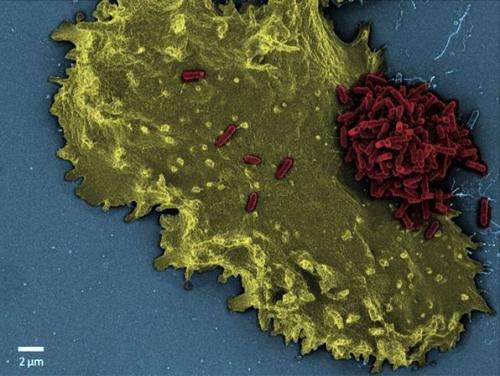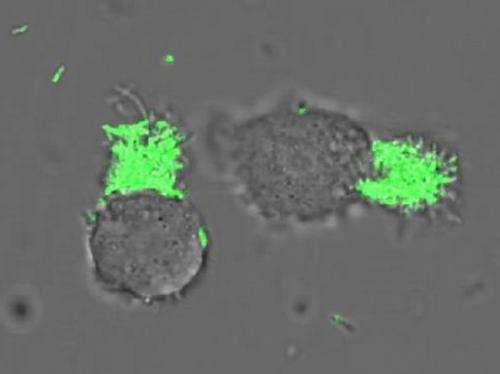Amoeba feast on backpacks

(�鶹��Ժ)—The amoeba Acanthamoeba cunningly traps motile bacteria, collecting them in a rucksack before devouring the whole backpack. This behaviour of the single-cell organisms is unique.
Listeria, which cause severe infections in humans, appear to have met their match: researchers from Professor Martin Loessner's group at ETH Zurich have discovered that they are – quite literally – easy prey for a particular species of amoeba.
The amoeba's tactics are shrewd. It immobilises the motile listeria, which are able to move using specific propellers called flagella. The single-cell organism then bundles the bacteria close together on its surface and forms a backpack. In order to do so, the amoeba relies on the motility of the bacteria. However, this is not enough in itself to form a tight bacteria package. Under the electron microscope, the researchers noticed that ultra-fine threads, so-called filaments, helped tie up the little parcel. The filaments are supposed to stem from the amoeba itself.
Amoeba devour backpack
Once the amoeba has finished its rucksack, it begins to devour it by phagocytosis. Once inside, the gourmet backpack is then digested completely. In the meantime the amoeba sets about collecting bacteria again.

However, it is not just listeria that amoebae seem to have an appetite for. The ETH-Zurich researchers' experiments reveal that other motile bacteria can also be absorbed in this way. They are also undeterred by the danger of potential intracellular pathogens.
"The formation of an edible backpack of motile bacteria had not been observed or studied in detail in the world of microorganisms before," says Markus Schuppler, a scientist from the Laboratory of Food Microbiology at ETH Zurich. The behaviour of these single-cell organisms is unique.
Bacteria completely digested
Originally, the researchers wanted to find out whether listeria are capable of living and multiplying in amoebae. Earlier research projects by other scientists indicated that the bacteria can survive in the single-cell organisms, effectively as training for life inside the cells of their victims, such as in the cells of the intestinal epithelium of humans.
However, the researchers managed to prove that this is not the case: once in the amoeba, the bacteria no longer come out alive. According to the researchers, within a few hours the listeria have completely been digested.
Listeria are dreaded pathogens of severe invasive infections in humans, who ingest them via contaminated food that has not been sufficiently heated before consumption. Outside the human body, the bacillary bacteria live off dead organic material. They share their environmental niches with numerous predatory protozoa. Under certain conditions, however, they can change their so-called saprophytic lifestyle to an intracellular one. In human cells, they can then multiply, spread and cause severe infections.
More information: Doyscher D, Fieseler L, Dons L, Loessner MJ, Schuppler M. Acanthamoeba feature a unique backpacking strategy to trap and feed on Listeria monocytogenes and other motile bacteria. Env Microbiology (2012).
Provided by ETH Zurich
















